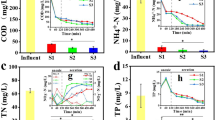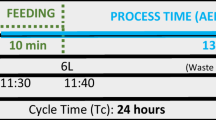Abstract
The removal of nitrophenols under denitrifying conditions was studied in bench-scale upflow anaerobic sludge blanket (UASB) reactors (R1, R2, R3 and R4) using three different carbon sources. Initially acetate was used as carbon source (substrate) in all the four reactors followed by glucose and methanol. Reactor R1 was kept as control and R2, R3, R4 were fed with 30 mg/l concentration of 2-nitrophenol (2-NP), 4-nitrophenol (4-NP), and 2,4-dinitrophenol (2,4-DNP), respectively. Throughout the study the hydraulic retention time (HRT) and COD/NO3 -–N ratio were kept as 24 h and 10, respectively. 2-Aminophenol (2-AP), 4-aminophenol (4-AP) and 2-amino,4-nitrophenol (2-A,4-NP) were found as the major intermediate metabolites of 2-NP, 4-NP and 2,4-DNP degradation, respectively. Methanol was found to be a better carbon source for 4-NP and 2,4-DNP degradation as compared to acetate and glucose, while 2-NP degradation was not influenced much by the change of substrate. Nitrate nitrogen removal was always more than 99%. COD removal efficiency of the nitrophenol fed reactors varied from 85.7% to 97.7%. The oxidation-reduction potential (ORP) inside the reactors dropped, up to –300 mv, with glucose as carbon source. As the reactors were switched over to methanol, ORP increased to –190 mv. The granular sludge developed inside the reactors was light brown in colour when acetate and glucose were used as substrate, which turned dark brown to black at the end of methanol run. Biomass yield in terms of volatile suspended solids was observed as 0.15, 0.089 and 0.14 g per gram of COD removal for acetate, glucose and methanol, respectively.
Similar content being viewed by others
References
APHA (1989) Standard Methods for the Examination of Water and Wastewater, 17th edn. American Public Health Association, Washington DC
Arvin E & Kristensen GH (1982) Effect of denitrification on the pH in biofilms. Water Sci. Technol. 14(8): 833-848
Bisaillon JG, Lepine F, Beaudet R & Sylvestre M. (1993) Potential for carboxylation-dehydroxylation of phenolic compounds by a methanogenic consortium. Can. J. Microbiol. 39: 642-648
Boopathy R, Wilson M & Kulph CF (1993) Anaerobic removal of 2,4,6-trinitrotoluene (TNT) under different electron accepting conditions: laboratory study. Water Environ. Res. 65(3): 271
Carley BN & Mavinic DS (1991) The effects of external carbon loading on nitrification and denitrification of a high-ammonia landfill leachates. J. Water Pollut. Control Fed. 63: 51-59
Donlon BA, Razo-Flores E, Field JA & Lettinga G (1995) Toxicity of N-substituted aromatics to acetoclastic methanogenic activity in granular sludge. Appl. Environ. Microbial. 61(11): 3889-3893
Donlon BA, Razo-Flares E, Lettinga G & Field JA (1996) Continuous detoxification, transformation, and degradation of nitrophenols in upflow anaerobic sludge blanket (UASB) reactors. Biotech. Bioeng. 51: 439-449
Environmental Protection Agency (1980) Ambient water quality for nitrophenols. EPA-440/5 80-063
Fang HHP & Chui HK (1993) Maximum COD loading capacity in UASB reactor at 37 °C. J. Envir. Engg. ASCE, 119(1): 103-119
Fang HHP, Chui HK & Li YY (1994) Microbial structure and activity of UASB granules treating different wastewaters. Water Sci. Tech. 30(12): 87-96
Fanning KF, John RC, Srivastava VJ, Jerger DE & Chynoweth DP (1983) Anaerobic processes. J.Water Pollut. Control Fed. 55(6): 623-632
Ghangrekar MM (1997) Studies on granulation, start-up and performance of upflow anaerobic sludge blanket reactor. Ph.D. Thesis, CESE, Indian Institute of Technology, Bombay, Mumbai, India
Gorontzy T, Kuver J & Boterogel KH (1993) Microbial Transformations of nitroaromatic compounds under anaerobic conditions. J. Gen. Microbiol. 139: 131-139
Gupta SK & Karim K (2000) Anaerobic degradation of nitrophenols by mixed culture under denitrifying condition. Proceeding IAWQ, Specailty Conference, Beijing, P.R. China, 18-20 Sepember, pp 351-360.
Haghighi-Podeh MR, Bhattacharya SK & Mingbo Q (1995) Effects of nitrophenols on acetate utilizing methanogenic systems.Water Res. 29(2): 391
Hendriksen HV & Ahring BK (1996) Integrated removal of nitrate and carbon in an upflow anaerobic sludge blanket (UASB) reactor: Operation performance. Water Res. 30(6): 1451-1458
Hess TF, Silverstein J, Schmidt SK & Howe B (1990) Supplemental substrate enhancement of 2,4-dinitrophenol degradation by a bacterial consortium. Appl. Environ. Microbiol. 56, 1551
Hess TF, Silverstein J & Schmidt SK (1993) Effect of glucose on 2,4-dinitrophenol degradation kinetics in sequencing batch reactors. Water Environ. Res. 65: 73
Jr. Safely LM & Westerman PW (1994) Low-temperature digestion of dairy and swine manure. Bioresource Technol. 47: 165-171
Kriek K (1979) Aromatic amines and related compounds as carcinogenic hazards to man. In: Emmelot P & Kriek E. (Eds). Environmental Carcinogenesis (pp 143-164). Elsevier Science, Amsterdam
Karim K (2001) Treatment of nitrophenolic wastewater using UASB reactor. Ph.D. Thesis, CESE, Indian Institute of Technology, Bombay, India
Karim K & Gupta SK (2001) Biotransformation of nitrophenols in upflow anaerobic sludge blanket reactors. Bioresource Technol. 80: 179-186
Karim K & Gupta SK (2002) Biosorption of nitrophenols on anaerobic granular sludge. Environ. Technol. 23(12): 1379-1384
Manoharan R, Liptak S, Parkinson P & Mavinic D (1989) Denitrification of high ammonia leachate using an external carbon source. Environ. Technol. Lett. 10: 707-716
O'Connor OA & Young LY (1989) Toxicity and anaerobic biodegradability of substituted phenols under methanogenic conditions. Environ. Toxicol. Chem. 8: 853-862
Prakash SM & Gupta SK (2000) Biodegradation of tetrachloroethylene in upflow anaerobic sludge blanket reactor. Bioresource Technol. 72: 47-54
Razo-Flores E, Donlon B, Lettinga G & Field JA (1997) Biotransformation and biodegradation of N-substituted aromatics in methanogenic granular sludge. FEMS Microbiol. Rev. 20(3-4): 525-538
Schmidth SK, Scow KM & Alexender M (1987) Kinetics of paranitrophenol degradation by a Pseudomonas sp.: effects of second substrates. Appl. Environ. Microbiol. 53: 2617-2627
Shelley MD, Autenrieth RL, Wild JR & Dale BE (1996) Thermodynamics analysis of trinitrotoluene biodegradation and mineralization pathways. Biotechnol. Bioeng. 50: 198-205
Spain JC, Wyss O & Gibson DT (1979) Enzymatic oxidation of p-nitrophenol. Biochem. Biophys. Res. Commun. 88: 34-645
Terada H (1981) The interaction of highly active uncouplers with mitochondria. Biochim. Biophys. Acta 639: 225-242
Tseng SK, & Lin MR (1994) Treatment of organic wastewater by anaerobic biological fluidized bed reactor. Water Sci. Technol. 29(12): 157
Uberoi V & Bhattacharya SK (1997) Toxicity and degradability of nitrophenols in anaerobic systems, Water Environ. Res. 69(2): 146-157
van Haandel ACV & Lettinga G (1994) Anaerobic sewage treatment, a practical guide for regions with a hot climate. JohnWiley & Sons, New York
Author information
Authors and Affiliations
Rights and permissions
About this article
Cite this article
Karim, K., Gupta, S. Effects of alternative carbon sources on biological transformation of nitrophenols. Biodegradation 13, 353–360 (2002). https://doi.org/10.1023/A:1022364616575
Issue Date:
DOI: https://doi.org/10.1023/A:1022364616575




